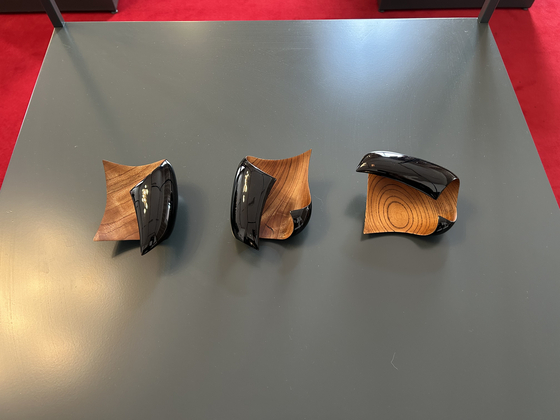From Milan to Seoul — this exhibition has crossed the globe
![The Glass Cube Room, filled with works from glass craftspeople, is the final section of the “Another Letter to Nature" exhibition at the Culture Station Seoul 284 in central Seoul. [SHIN MIN-HEE]](https://koreajoongangdaily.joins.com/data/photo/2023/04/04/8ba4a5c6-5b3d-4df0-9f83-4a780859e63f.jpg)
The Glass Cube Room, filled with works from glass craftspeople, is the final section of the “Another Letter to Nature" exhibition at the Culture Station Seoul 284 in central Seoul. [SHIN MIN-HEE]
Hosted and organized by the Ministry of Culture, Sports and Tourism and the Korea Craft and Design Foundation (KCDF), the latest edition was held last June at the Fondazione Giangiacomo Feltrinelli in Milan.
“It’s an extremely meaningful venue in that it boasts an extensive history,” said Kim Tae-hoon, president of the KCDF during a press event on Monday. “However, because the space is limited, we felt like the exhibition was unable to fully display its crafts to the extent possible. That’s why for its homecoming show, we added many more artists and pieces.”
The original Milan exhibition was held under the theme “Again, From the Earth’s Foundation” and promoted some 100 works from 22 designers and craftspeople. In the Korean version, slightly modified to the theme “Another Letter to Nature,” artistic director Kang Shin-jae increased the number to 89 creative individuals or teams with over 500 pieces.
It is currently being held at the Culture Station Seoul 284 in Jung District, central Seoul.
“The earth has been sending humans many messages that we’ve obviously been ignoring,” Kang said the same day. “Now we’re seeing cherry blossoms in late March when they should be blooming in April all due to global warming. That’s why this exhibition is like a reply to its Milan counterpart. We arranged leaflets for each of the seven sections in short letter formats and they are responses to nature.”
![An installation view of the "Another Letter to Nature" exhibition [KOREA CRAFT AND DESIGN FOUNDATION]](https://koreajoongangdaily.joins.com/data/photo/2023/04/04/5d5cc44b-b7a1-4ffd-aff7-f7b1091dbbf9.jpg)
An installation view of the "Another Letter to Nature" exhibition [KOREA CRAFT AND DESIGN FOUNDATION]
Both exhibitions put emphasis on appreciating mother nature and the fact that many craftspeople create their works using materials that “derive from the earth,” like stone. In order to do this, Kang stressed that he tried to create a “dreamlike” vibe that allows visitors to experience something similar to a walk in nature.
“I’d always pictured the exhibition in my head to depict the beginning of nature; somewhat similar to the Garden of Eden. Of course, no one actually knows what it looked like, which is why I described it as ‘dreamlike.’ In sections like the ‘Glass Cube Room’ [the final section of the exhibit] it is much more surreal when you actually see it, and not in pictures.”
The Glass Cube Room is what its name implies: a huge transparent shelf lit up with an arrangement of hundreds of glass crafts, including cups, vases and plates. Ten professional glass craftspeople, along with 29 students majoring in glass craft from Namseoul University, Kookmin University, Cheongju University and Hongik University have contributed to making the room ethereal.
“You can also think of the entire shelf as just one whole object because the harmony coming from the colors and light of each glass piece makes it so beautiful and infinite,” Kang said.
Kang lamented about the missed potential of handcrafted accessories.
“They are so elaborately precise and are exquisitely made from each craftperson’s own know-how that I wished they could be expanded even further to a canvas with a painting-like approach,” Kang said.

![Park Joo-hyung's wooden otchil (lacquer-coating) accessories, top, and enlarged canvas versions that have become wall art. [SHIN MIN-HEE]](https://koreajoongangdaily.joins.com/data/photo/2023/04/04/3ac6f058-8b0c-496f-97a3-890823b1b5c1.jpg)
Park Joo-hyung's wooden otchil (lacquer-coating) accessories, top, and enlarged canvas versions that have become wall art. [SHIN MIN-HEE]
His vision came to life with Park Joo-hyung’s wooden otchil (lacquer-coated) accessories, which are on display alongside four enlarged versions placed in a frame.
“In the Milan exhibition, we made sure to show traditional Korean materials and techniques, including otchil,” Kang said. And like its theme, naturally-derived materials are one key player.
Craftsperson Jang Sung’s “Given” (2023), the main installation of the show, centers on rocks. Several large stones are each placed on wooden pedestals with a screen showing “portraits” of said rocks.
Facing “Given” on the opposite side is one of Jang's previous plastic geometric installations, which he admitted was “against the exhibition’s intention.”
!["Given" (2023) by Jang Sung [KOREA CRAFT AND DESIGN FOUNDATION]](https://koreajoongangdaily.joins.com/data/photo/2023/04/04/eb8d31b4-f3f7-4bbb-bf53-7743b0b9e32f.jpg)
"Given" (2023) by Jang Sung [KOREA CRAFT AND DESIGN FOUNDATION]
“Another Letter to Nature” continues until June 4. Culture Station Seoul 284 is open every day from 11 a.m. to 7 p.m. except Mondays. The exhibition is free to all.
BY SHIN MIN-HEE [shin.minhee@joongang.co.kr]










with the Korea JoongAng Daily
To write comments, please log in to one of the accounts.
Standards Board Policy (0/250자)